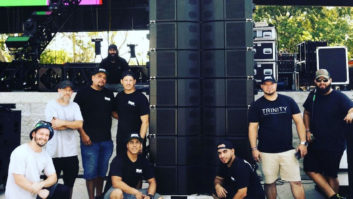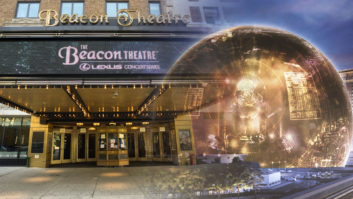Upon entering the premises of Advantage Audio in Burbank, the first impression is of decks cleared for action. There’s nothing extraneous, nothing out of place, nothing cluttering up the cool-but-not-cold interior expanses of gray carpet, tile and brick.
A conversation with owners Bill Koepnick and Jim Hodson proves that the impression is correct-Advantage Audio is a very busy place. But Koepnick and Hodson, an articulate and business-like but very friendly duo, took time out to relax and chat for a few moments in their revamped Studio B, newly fitted with a Studer D950S digital console. Studio B, complete with a large, cozy fireplace set into a sandblasted brick wall, and a high, peaked ceiling, is an elegant combination of warmth, comfort and high-tech efficiency. It is also, as Advantage’s brochure tells us, “a vast repository of cartoonal knowledge.” These are the people who turn out the sound for Hercules, Robocop, Godzilla, Men in Black, Jumanji, Spiderman, Earthworm Jim-you name it. Or, better yet,have your kids name it.
“I think it’s safe to say we do more audio for animation than any other single facility,” comments Hodson. “Spawn, which is a late-night, adult show, is probably the highest-profile show we’re currently working on; we also do a lot of work for Disney, and we just finished Invasion America, a Spielberg show for Dreamworks that was a lot of fun. Our client base is MGM, Universal, Disney, HBO, Columbia TriStar-over the years we’ve worked with just about everybody.”
Besides the Studer console, other equipment highlights at Advantage are the Otari Radar 24-track hard disk recorder, Doremi Labs V1 digital video (nothing rewinds at this facility!), and something like 20 Pro Tools systems, including four in Studio B alone, used for most of the audio sources: sound effects, dialog and music. Foley is currently being recorded to the Radar but is soon to be switched over to Pro Tools.
“We’ve been doing animation for a long time,” says Koepnick. “Originally, Jim and I worked in various areas, like promo and live action. Then we wound up with a cartoon series, got good at doing it, and decided that it was a niche we could stick with. In 1989 we incorporated and started looking for a building. Shortly thereafter, we found this place and pretty much gutted it. We started small, with one mixing stage, a Foley stage and an effects room. It was just the two of us; we shared an office and were a two-man band. We were secretary, janitor, business owner, sound designer, mixer, salesman, collections department-that’s what it’s like to get a business off the ground; you do whatever it takes. We opened the doors with 13 half-hours that first year. It was nerve-wracking, because after that season was over we were standing there looking at each other, going, ‘We’ve got to go out and find some more work!'”
“That first series was the original Ghostbusters for [animation production company] DIC,” adds Hodson. “We won a Golden Reel award and an Emmy for it. The following year, we did Captain Planet, also for DIC. We’d been soliciting Disney’s work for a long time, and in our third year in business, they finally gave us a shot at doing a series. They’ve been with us ever since, and it’s been a wonderful relationship. All around, business has continued to grow incrementally since then.”
The staff at Advantage does everything except record the music and dialog. “We do dialog editing, sound effects creation and editing and music editing,” explains Koepnick. “We have excellent music editors on staff; frequently, we get a library of cues, and we cut it to picture. Or, often a show is scored, but if it’s a large series, they’ll do score for only the first five or ten shows, and the balance of the shows will be all editing, taking those first shows and using them as source material. We cut and rearrange it for the rest of the shows. It’s quite an art, a lot of surgery. We also do Foley recording, and we put everything together, mix it and lay it back to their master. We can put it right to Digi Beta if the client wants.”
The full-time staff at Advantage now numbers 17. “We hire a few extra people during the busiest time of the year, between August and December,” notes Hodson, “when we wind up doing ten half-hours a week. We pride ourselves on the fact that we are pretty much state of the art-we’re well-organized and we run very efficiently. We have to because of the volume of work that we’ll turn out in a short amount of time. We’ll be doing dialog editorial, music editorial, all the Foley sound effects, the mix and the laybacks on ten different shows, in five days.”
The task of changing over to being fully digital at the facility is almost complete. “We’ve worked really hard to get the signal path from start to finish completely digital,” says Koepnick, “hence the purchase of the Studer consoles. We want to keep the conversions to a minimum. For the world we’re working in it’s really quite amazing what that does to the sound. I’ve been sort of skeptical about digital, as a buzz word, even though we’ve been doing digital editing since the beginning of Sound Designer. But what we’re finding is, the fewer analog-to-digital conversions you make, the more accurate the sound remains. When you do the amount of transfers that this business demands, staying digital really makes a difference.”
Koepnick and Hodson are happy with their choice of the Studer D950S, and a second one was slated to be online in Studio A in February. “The Studer D950S is just truly an amazing board,” says Koepnick. “We’d been kicking this decision around for a while, then, we were at NAB last April, and we looked at everything-Neve, SSL, Studer, Otari-and we were both struck with the fact that there’s a wonderful kind of simplicity to the D950S console. It’s simple when you first sit down and look at it, but it’s as complex as the space shuttle if you want it to be.”
“Bill and I have had a long-standing relationship with John Carey, who is president of Studer North America,” adds Hodson. “We walked around the show and saw everything, then we came back to his booth and said, ‘Show us what this board will do.’ He took us through it, and we left thinking we’d have to go a long way to beat it. We tried to stay open-minded, but when we sat down and figured out our needs, and what we felt would take us down the line, there were three factors: Studer’s reputation, this particular piece of equipment, and the relationship we have with John. The board went in before Christmas, and now we’re both sitting on the happy side of the fence, very glad we made this selection.”
“The learning curve is kind of steep,” admits Koepnick, “but if you know how to work a console to begin with, if you understand signal flow, this follows all the rules. You’re not learning a whole new vocabulary, you’re not trying to change careers just to learn how to mix on the thing. It has a lot of levels. When the board shows up, it’s basically a clean slate and you can do whatever you want to with it. Buying one of these is a little more complicated than buying an analog console, where it’s, ‘I’m getting this many inputs’ and you can see them and you know what they’re all going to do. This is a really powerful computer, and all its audio processing capability can be parceled out in a number of different configurations. You can have a stereo console, an LCRS console, you can set it up for 5.1 or 7.1, you can do completely different jobs on it from day to day. You can call a configuration up offline on a laptop computer and just load it in, and the console changes character. You tell it how many inputs you need, how many stereo modules, how many mono modules, how many buses, and basically design it.”
Almost the entire Advantage facility-two mix stages, a Foley stage and four editing rooms-are fitted with freestanding PMC monitors powered by Bryston amps. “It’s a very hot combination,” says Koepnick. “When we made the switch, our editors were really surprised. Suddenly people could hear better, and it translates very well to the real world, without any kind of hype or coloration.”
With the kind of workload and turnaround times that Advantage deals with on an everyday basis, every little bit helps-from compatible speaker systems in all the rooms to compatible consoles, and lots of Pro Tools systems. “An animated show’s soundtrack can be really intense,” concludes Hodson. “There may be 2,000 sound effects in 22 minutes. Our clients, and the producers and directors, have become very sophisticated over the years. They expect sound that compares to the big movies that they go out and see on the weekend. There’s a lot of quality and attention to detail in this work-it’s definitely not just slap some sound on and throw it on Saturday morning. Our editors don’t just edit, they’re really sound designers. You have to come up with ideas and sounds constantly for cartoons. Because it’s all imaginary to begin with, you are always trying to create a different reality. That’s the fun of it, and the challenge of it.”






